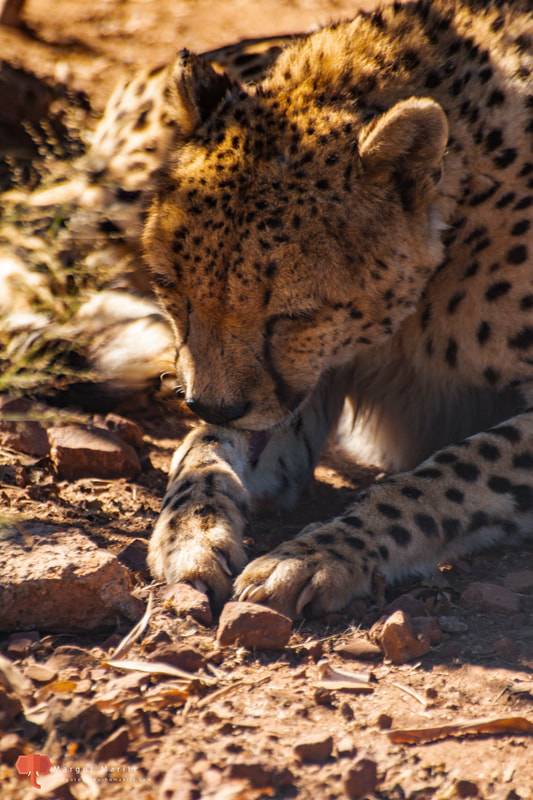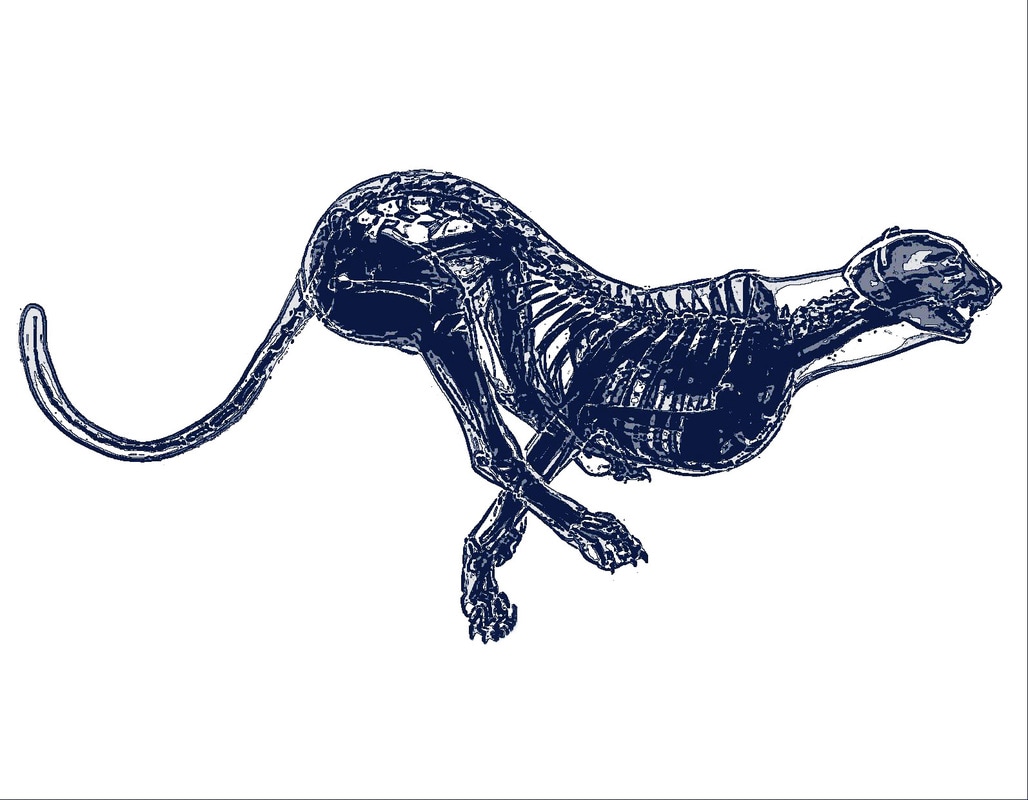Cheetah
The leopard ferocious and shrewd. But elegant and graceful best describes the cheetah. The cheetah is smaller than the other two cats, but by far the fastest at speeds of 70 miles per hour it can run faster than all other animals.
Now restricted to sub-Saharan Africa, wild cheetahs once were found in most of Africa, the plains of southern Asia, the Middle East and India.
Physical Characteristics
Habitat
Cheetahs are found in open and partially open savannas. It prefers to frequent open plains as is often depicted in films, but they are also at home in savannah woodland areas. This rare and totally protected species is found only in the Kalahari and remote areas of the Northern Province and Mpumalanga, as well as sporadically in the Northern Cape Province.
Behavior
Diet
The Cheetah's main prey is medium to small antelope such as Steenbok and Duiker, Thomson's Gazelle and Springbok, but there have been accounts of males grouping together to hunt larger prey such as Wildebeest. They also prey on Baboons, ground-living Birds, Bustards, Hares and Porcupines.
Once a cheetah has made a kill, it eats quickly and keeps an eye out for scavengers, lions, leopards, hyenas, vultures and jackals will occasionally take away their kills. Although cheetahs usually prey on the smaller antelopes such as Thomson's gazelles and impalas, they can catch wildebeests and zebras if hunting together. They also hunt hares and other small mammals and birds.
Although known as an animal of the open plains that relies on speed to catch its prey, research has shown that the cheetah depends on cover to stalk prey. The cheetah gets as close to the prey as possible, then in a burst of speed tries to outrun its quarry. Once the cheetah closes in, it knocks the prey to the ground with its paw and suffocates the animal with a bite to the neck.
Caring for the young Cheetah
With a life span of 10 to 12 years, the cheetah is basically a solitary animal. At times a male will accompany a female for a short while after mating, but most often the female is alone or with her cubs. Two to four cubs are born in a secluded place. Their eyes do not open for a week or two, and they are helpless at first. When the mother is hunting, she leaves them hidden, but by 6 weeks of age they are able to follow her. They are suckled for 2 to 3 months but begin to eat meat as early as 3 weeks.
By 4 months the cheetah cub is a tawny yellow and almost completely spotted; the tail has bands of black and by adulthood a white tip. The grayish mantle disappears more slowly; the last traces are still visible when the cubs are adult-sized at 15 months.
Predators
A shy creature that roams widely, the cheetah is not seen as easily as some other cats. Never numerous, cheetahs have become extinct in many areas, principally due to shrinking habitat, loss of species to prey upon, disease and a high rate of cub mortality. In some areas 50 to 75 percent of all cheetah cubs die before 3 months.
Did you know?
Sources:
http://www.krugerpark.co.za/africa_cheetah.html
http://www.outtoafrica.nl/animals/engcheetah.html?zenden=2&subsoort_id=2&bestemming_id=1
The leopard ferocious and shrewd. But elegant and graceful best describes the cheetah. The cheetah is smaller than the other two cats, but by far the fastest at speeds of 70 miles per hour it can run faster than all other animals.
Now restricted to sub-Saharan Africa, wild cheetahs once were found in most of Africa, the plains of southern Asia, the Middle East and India.
Physical Characteristics
- The cheetah is built for speed. It has long, slim, muscular legs, a small, rounded head set on a long neck, a flexible spine, a deep chest, no retractable claws, special pads on its feet for traction and a long, tail for balance.
- Although fast, the cheetah cannot run at full speed for long distances (100 yards is about the limit) because it may overheat.
- Cheetahs have distinctive black "tear stripes" that connect from the inside corner of each eye to the mouth that may serve as an antiglare device for daytime hunting.
- The Cheetah is credited as being the fastest land animal over short distances, and can reach speeds of up to 90 km/h (55.9 m/h) in pursuit of prey.
- This Cat is characterized by a slender body, long legs, and a distinctly rounded head with small rounded ears which are set wide apart.
- It measures two meters from the snout to the tip of the tail, has a mass of 40 - 60 Kg's, and stands about 800mm high.
- It has a concave back and lower hind quarters.
- This cat is characterized by a strongly spotted coat and by a long tail which is half as long as the length of its head and body.
- The tail has a unique pattern of striped markings.
Habitat
Cheetahs are found in open and partially open savannas. It prefers to frequent open plains as is often depicted in films, but they are also at home in savannah woodland areas. This rare and totally protected species is found only in the Kalahari and remote areas of the Northern Province and Mpumalanga, as well as sporadically in the Northern Cape Province.
Behavior
- They live in family groups of two to six strong, although some individuals prefer a solitary existence at times. Its historical distribution has been greatly reduced and modified.
- Cheetahs have disappeared from very large areas of the African continent due to modern man's colonization.
- Cheetahs are predominantly diurnal, with peaks of activity at sunrise and sunset.
- Choosing an elevated resting place, they lie up in the shade during the hottest hours of the day.
- Those who have never heard a Cheetah's call will be very surprised to hear it make an almost bird-like chirp.
- While they also growl, snarl and hiss like domestic Cats, they do not roar as some people might expect them to.
- Cheetah mothers spend a long time teaching their young how to hunt small live antelopes are brought back to the cubs and released so they can chase and catch them.
- Unlike most other cats, the cheetah usually hunts during daylight, preferring early morning or early evening, but is also active on moonlit nights.
- Cheetahs do not roar like lions, but they purr, hiss, whine and growl. They also make a variety of contact calls, the most common is a birdlike chirping sound.
Diet
The Cheetah's main prey is medium to small antelope such as Steenbok and Duiker, Thomson's Gazelle and Springbok, but there have been accounts of males grouping together to hunt larger prey such as Wildebeest. They also prey on Baboons, ground-living Birds, Bustards, Hares and Porcupines.
Once a cheetah has made a kill, it eats quickly and keeps an eye out for scavengers, lions, leopards, hyenas, vultures and jackals will occasionally take away their kills. Although cheetahs usually prey on the smaller antelopes such as Thomson's gazelles and impalas, they can catch wildebeests and zebras if hunting together. They also hunt hares and other small mammals and birds.
Although known as an animal of the open plains that relies on speed to catch its prey, research has shown that the cheetah depends on cover to stalk prey. The cheetah gets as close to the prey as possible, then in a burst of speed tries to outrun its quarry. Once the cheetah closes in, it knocks the prey to the ground with its paw and suffocates the animal with a bite to the neck.
Caring for the young Cheetah
With a life span of 10 to 12 years, the cheetah is basically a solitary animal. At times a male will accompany a female for a short while after mating, but most often the female is alone or with her cubs. Two to four cubs are born in a secluded place. Their eyes do not open for a week or two, and they are helpless at first. When the mother is hunting, she leaves them hidden, but by 6 weeks of age they are able to follow her. They are suckled for 2 to 3 months but begin to eat meat as early as 3 weeks.
By 4 months the cheetah cub is a tawny yellow and almost completely spotted; the tail has bands of black and by adulthood a white tip. The grayish mantle disappears more slowly; the last traces are still visible when the cubs are adult-sized at 15 months.
Predators
A shy creature that roams widely, the cheetah is not seen as easily as some other cats. Never numerous, cheetahs have become extinct in many areas, principally due to shrinking habitat, loss of species to prey upon, disease and a high rate of cub mortality. In some areas 50 to 75 percent of all cheetah cubs die before 3 months.
Did you know?
- The name cheetah comes from an Indian word meaning "spotted one."
- The young cub has a long gray-blue coat and a black underbelly that rapidly lightens and becomes spotted.
- Early peoples trained cheetahs for hunting, and many civilizations depicted them in their art and in written records.
- Cheetahs were so popular that Akbar the Great of India was said to have kept a stable of about 1,000.
- The King Cheetah is not a species on its own, but rather a natural phenomenon amongst the Cheetah family, where at times young are naturally born with this coloring.
- The King Cheetah is mainly observed in the Kruger National Park and the northern Gauteng.
- Although not touching the ground when immobile, their claws protract with every step taken, thus gripping the ground.
Sources:
http://www.krugerpark.co.za/africa_cheetah.html
http://www.outtoafrica.nl/animals/engcheetah.html?zenden=2&subsoort_id=2&bestemming_id=1





